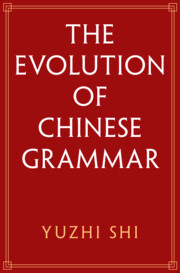Book contents
- The Evolution of Chinese Grammar
- The Evolution of Chinese Grammar
- Copyright page
- Dedication
- Epigraph
- Contents
- Figures
- Tables
- Acknowledgments
- Conventions Used in the Examples
- Abbreviations and Symbols
- 1 Some Preliminaries
- 2 Copular Word and Construction
- 3 Focus and Wh- Words
- 4 Serial Verb Construction
- 5 Disyllabification
- 6 Resultative Construction
- 7 Information Structure
- 8 The Passive Construction
- 9 The Disposal Construction
- 10 Verb Copying and Reduplication
- 11 The Comparative Construction
- 12 The Ditransitive Construction
- 13 Aspect and Tense
- 14 Negation
- 15 The Boundedness of the Predicate
- 16 Classifiers
- 17 Demonstratives from Classifiers
- 18 Distal Demonstratives from Phonological Derivation
- 19 Pronouns, Plurals, and Diminutives
- 20 Structural Particles
- 21 Word Order and Relative Clauses
- 22 Conclusions
- References
- Primary Sources of Texts
- Index
13 - Aspect and Tense
Published online by Cambridge University Press: 16 March 2023
- The Evolution of Chinese Grammar
- The Evolution of Chinese Grammar
- Copyright page
- Dedication
- Epigraph
- Contents
- Figures
- Tables
- Acknowledgments
- Conventions Used in the Examples
- Abbreviations and Symbols
- 1 Some Preliminaries
- 2 Copular Word and Construction
- 3 Focus and Wh- Words
- 4 Serial Verb Construction
- 5 Disyllabification
- 6 Resultative Construction
- 7 Information Structure
- 8 The Passive Construction
- 9 The Disposal Construction
- 10 Verb Copying and Reduplication
- 11 The Comparative Construction
- 12 The Ditransitive Construction
- 13 Aspect and Tense
- 14 Negation
- 15 The Boundedness of the Predicate
- 16 Classifiers
- 17 Demonstratives from Classifiers
- 18 Distal Demonstratives from Phonological Derivation
- 19 Pronouns, Plurals, and Diminutives
- 20 Structural Particles
- 21 Word Order and Relative Clauses
- 22 Conclusions
- References
- Primary Sources of Texts
- Index
Summary
The emergences of the aspect suffixes le (perfective) and zhe (progressive) were epoch-marking events in the history of Chinese grammar, and their development processes should be seriously studied. This chapter explains the reasons why they emerged at the time they did. Two closely related questions need to be answered: what factors in the earlier grammatical system blocked aspect suffixes from grammaticalizing? What changes in the grammar at the time made it possible for them to come into existence? The motivation and mechanism for their development involves two factors: (a) the overall change of the grammatical system at the time and (b) the concrete grammaticalization process of each aspect suffix.
- Type
- Chapter
- Information
- The Evolution of Chinese Grammar , pp. 326 - 367Publisher: Cambridge University PressPrint publication year: 2023

